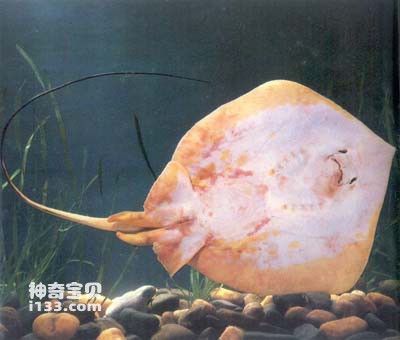The red stingray (Dasyatis akajei) belongs to the class Chondrichthyes, the superorder Hypospora, the order Rayniformes, the family Stryidae, and the genus Stingray. Commonly known as: catfish, straw hat fish, fanfish, stingray. English name: Red stingray.
The body is extremely flat, the body disk is nearly round, and the width is greater than the length. The snout is broad and short, with a sharp tip and a snout length of 1/4 of the body disc length. The eyes are small, protruding, almost as big as the blowhole. The spout hole is immediately behind the eyes; the mouth, nostrils, gill openings, and cloaca are all located on the ventral surface of the body disc. The nostrils are in front of the mouth, and the nasal valves extend into the cleft of the mouth. The mouth is small, the cleft is wavy, and there are 5 papillae on the floor of the mouth, with 3 prominent ones in the middle. The teeth are small and arranged in a pavement shape. There is a longitudinal row of spines in the middle of the back of the body disc, and the larger one is at the tail; there are 1 or 2 rows of spines on both sides of the shoulder area. The front part of the tail is broad and flat, and the rear part is as slender as a whip. Its length is 2-2.7 times the length of the body plate. There is a serrated flat tail spine in the front part, and there is a venom gland at the base of the tail spine. After the tail spine, there is a membrane on the dorsal and ventral surfaces of the tail, and the ventral surface is higher and longer. The back of the body disk is auburn, with slightly lighter edges; the outside of the eyes, the inner edge of the blowhole and both sides of the tail are orange, and the ventral surface of the body disk is milky white with orange edges.

Red rays are bottom-dwelling fish that often live in deep pools with sandy bottoms. They are mostly active at night and feed mainly on small fish, shrimps and molluscs. Red rays are ovoviviparous fish. Fishermen believe that they mate in spring and lay eggs in autumn, with 7 or 8 eggs being laid every time. The female fish protects her larvae.
Red rays are distributed in the South China Sea and East China Sea in my country, and are also found in the brackish water of the Yangtze River Estuary. Pure freshwater red rays are only found in Nanning and Longzhou in the upper reaches of Zuojiang River in Guangxi, and are also found in southern Japan and the coast of the Philippines. Red stingrays were originally a marine fish. In ancient times, they remained in inland waters after the seawater withdrew from Guangxi. They were gradually "land sealed" and settled in Guangxi around the end of the Tertiary and Pliocene epochs of the Cenozoic Era.
Red rays are larger in size, with the largest individual weighing 65-70 kilograms in the ocean, usually around 5-8 kilograms; common individuals in freshwater are about 50-70 centimeters in length, weighing 1.5 kilograms, and the largest individual can reach 15 kilograms. The meat tastes good, the skin is thick, bloodless and shiny, and rich in colloid. After it is boiled, it is cooked into "big grilled fish skin", which is delicious and is a treasure at banquets.
The stingray's tail sting is poisonous. Living animals often swing their tails to sting, and people are often stabbed when fishing or handling fish. Because there are inverted serrations on both sides of the tail spine, when they are pierced into the skin and then pulled out, the serrations on both sides of the tail spine often cause severe lacerations to the surrounding tissue, and the venom secreted by the tail spine's venom glands causes the patient to immediately experience severe pain and burning sensations, and then Pains and cramps all over the body. The wound quickly turns gray and pale, and then the surrounding skin becomes red and swollen, accompanied by systemic symptoms such as drop in blood pressure, vomiting, diarrhea, fever and chills, rapid heartbeat, muscle paralysis, and even death. It's fine if treated in time. If not treated properly, it may recur after a few days, with sequelae. For example, if a finger is injured, the finger will become stiff and unable to bend.
In addition to being eaten, red stingrays also have certain medicinal value. Its meat is sweet, salty, non-toxic, and has the effect of replenishing qi. Use it to boil oil to treat malnutrition in children. The venom of tail poison is a kind of amino acid and polypeptide protein. Its medicinal properties are salty, cold, and slightly poisonous. It has certain effects on the central nervous system and heart, and has the effects of clearing away heat, reducing inflammation, resolving knots, and removing diseases. The tail spines are ground into powder and used as medicine. It has certain effects on the treatment of gastric cancer, esophageal cancer, lung cancer, mastitis, pharyngitis, malaria, toothache, and stingray tail spines. In addition to being used as a raw material for making cod liver oil, its liver can cure night blindness after cooking.
animal tags:
We created this article in conjunction with AI technology, then made sure it was fact-checked and edited by a Animals Top editor.